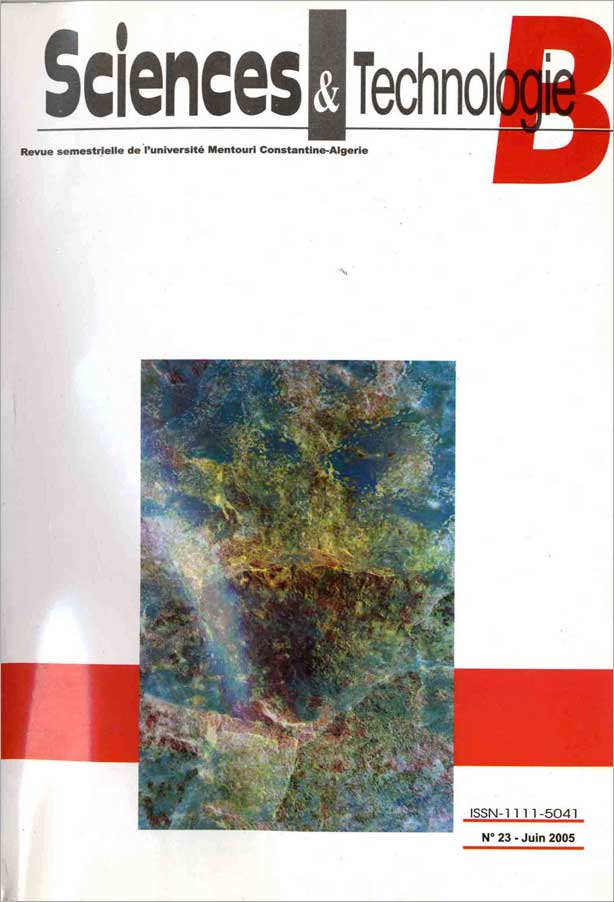ُETUDE NUMERIQUE DE LA CONVECTION MIXTE LAMINAIRE DANS DES CAVITES VENTILEES
Mots-clés :
Convection mixte, Méthode des différences finies, Cavité ventilée, Méthodes numériques, Mixed convection, Différences finies méthode, Ventilated enclosure, Numerical methodsRésumé
In this work, we present a numeric study of the phenomenon of laminar mixed convection in a ventilated square cavity, of which one of partitions is submitted to a constant temperature, while the other partitions are considered like adiabatic. Equations governing this phenomenon were
discrétised by the method of differences finished and a code of calculation has been developed to determine all the structure of the out-flow. Results are presented under shape of fields streamlined and thermal for different values of numbers of Richardson. These show the apparition of recirculation contrarotatives zones in the superiorpart of the cavity when the forced convection predominates.
Références
-Kuper.R.A, Van Dermeer TH.H, Hoocfem Doorm C.J, and
Hemres R.AW.M , Numerical study of lamina and turbulent natural convection in an inclined square cavity, Int.J.Heat Mass Transfer. Vol36. No11 pp2899-2911, (1993).
-Angirasa D., Mixed convection in a vented enclosure with n isothermal vertical surface, Fluid Dynamics Research 26, pp
-233, (2000).
-Torrance K, Davis R., Eike K., Gill P., Gutman D., Hsui
A., Lyons S., Zien H., Cavity fows driven by buoyancy and
shear, J. Fluid Mech, Part 2 51, pp 221 - 231, (1972).
-Sparrow E.M., Samie F., Interaction between a stream
which passes through an enclosure and natural convection, Int. J. Heat Mass Transfer 25, pp 1489-1502, (1982).
-Oosthuisen P.H. Paul J. T, Mixed convective heat transfer in a cavity.Fundamental forced and mixed convection, in: 23
rd national heat transfer conference, Denver, Colorado, HTD,
Vol 42, pp 159-169, (1985).
-To W.M, Humphery J. A. C., Numerical simulation of
buoyant turbulent flow. I.- Free convection along a heated
vertical, flat plate. II - Free and mixed convection in a heated
cavity, Int. J. Heat Mass Transfer 29, pp 573-610, (1986).
-Simoneau J.P,Draoui A, Allard F,Problèmes posés par la
convection mixte dans la climatisation de l’habitat: première approche en régime laminaire, Rev. Gén. Therm 325, pp 31-39, (1989).
-Papanicolaou E , Jaluria Y , Mixed convection from an isolated heat source in a rectangular enclosure, Numer. Heat Transfer Part A 18, pp 427-461, (1990).
-Papanicolaou E , Jaluria Y , Transition to a periodic regime in mixed convection ina square cavity, J. Fluid Mech 239, pp 489-509, (1992).
-Papanicolaou E., Jaluria Y., Mixed convection from a
localized heat source in a cavity with conducting walls. Numer. Heat Transfer Part A 23, pp 463-484, (1993).
-Kotake S, Hijikata K, Numerical simulations of heat
transfer and fluid flow on a personal computer, Vol 3, Tom 3,
pp 31-33, editor: Mujumdar A.S., Quebec, Canada, (1993).
-Saatdjian E., Phénomènes de transport et leurs résolutions numériques. Polytechnica, pp 260-263 (1998).
-Sewell G., The numerical solution of ordinary and partial
differential equations, Edition Academic Press Inc, London,
(1988).
-Anderson D. A; Tannehill J. C; Richard Pletcher H ,
Computational fluid mechanics and heat transfer, p 507,
second edition, editor : Mincowicz M.J. and Sparrow E.M,
Paris, France, (1984).
Téléchargements
Publié
Numéro
Rubrique
Licence
Les auteurs publiant dans cette revue acceptent les termes suivants :- Les auteurs détiennent le droit d'auteurs et accordent à la revue
le droit de première publication, avec l’ouvrage disponible simultanément [SPÉCIFIER LA PÉRIODE DE TEMPS] après publication, sous la licence Licence d’attribution Creative Commons qui permet à d'autres de partager l'ouvrage en en reconnaissant la paternité et la publication initiale dans cette revue. - Les auteurs peuvent conclure des ententes contractuelles additionnelles et séparées pour la diffusion non exclusive de la version imprimée de l'ouvrage par la revue (par ex., le dépôt institutionnel ou la publication dans un livre), accompagné d'une mention reconnaissant sa publication initiale dans cette revue.
- Les auteurs ont le droit et sont encouragés à publier leur ouvrage en ligne (par ex., dans un dépôt institutionnel ou sur le site Web d'une institution) avant et pendant le processus de soumission, car cela peut mener à des échanges fructueux ainsi qu'à un nombre plus important, plus rapidement, de références à l’ouvrage publié (Consulter The Effect of Open Access).

